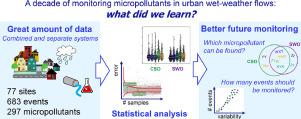Water Research ( IF 11.4 ) Pub Date : 2022-08-09 , DOI: 10.1016/j.watres.2022.118968 Lena Mutzner 1 , Viviane Furrer 2 , Hélène Castebrunet 3 , Ulrich Dittmer 4 , Stephan Fuchs 5 , Wolfgang Gernjak 6 , Marie-Christine Gromaire 7 , Andreas Matzinger 8 , Peter Steen Mikkelsen 1 , William R Selbig 9 , Luca Vezzaro 1

|
Urban wet-weather discharges from combined sewer overflows (CSO) and stormwater outlets (SWO) are a potential pathway for micropollutants (trace contaminants) to surface waters, posing a threat to the environment and possible water reuse applications. Despite large efforts to monitor micropollutants in the last decade, the gained information is still limited and scattered. In a metastudy we performed a data-driven analysis of measurements collected at 77 sites (683 events, 297 detected micropollutants) over the last decade to investigate which micropollutants are most relevant in terms of 1) occurrence and 2) potential risk for the aquatic environment, 3) estimate the minimum number of data to be collected in monitoring studies to reliably obtain concentration estimates, and 4) provide recommendations for future monitoring campaigns. We highlight micropollutants to be prioritized due to their high occurrence and critical concentration levels compared to environmental quality standards. These top-listed micropollutants include contaminants from all chemical classes (pesticides, heavy metals, polycyclic aromatic hydrocarbons, personal care products, pharmaceuticals, and industrial and household chemicals). Analysis of over 30,000 event mean concentrations shows a large fraction of measurements (> 50%) were below the limit of quantification, stressing the need for reliable, standard monitoring procedures. High variability was observed among events and sites, with differences between micropollutant classes. The number of events required for a reliable estimate of site mean concentrations (error bandwidth of 1 around the “true" value) depends on the individual micropollutant. The median minimum number of events is 7 for CSO (2 to 31, 80%-interquantile) and 6 for SWO (1 to 25 events, 80%-interquantile). Our analysis indicates the minimum number of sites needed to assess global pollution levels and our data collection and analysis can be used to estimate the required number of sites for an urban catchment. Our data-driven analysis demonstrates how future wet-weather monitoring programs will be more effective if the consequences of high variability inherent in urban wet-weather discharges are considered.
中文翻译:

十年监测城市潮湿天气中的微污染物:我们学到了什么?
下水道溢流 (CSO) 和雨水排放口 (SWO) 的城市潮湿天气排放是微污染物(微量污染物)进入地表水的潜在途径,对环境和可能的水再利用应用构成威胁。尽管在过去十年中为监测微污染物做出了巨大努力,但获得的信息仍然有限且分散。在一项元研究中,我们对过去十年在 77 个地点(683 个事件,297 个检测到的微污染物)收集的测量数据进行了数据驱动分析,以调查哪些微污染物在 1)发生和 2)对水生环境的潜在风险方面最相关, 3) 估计监测研究中要收集的最小数据数量,以可靠地获得浓度估计值,以及 4) 为未来的监测活动提供建议。与环境质量标准相比,我们强调微污染物的高发生率和临界浓度水平,因此应优先考虑。这些顶级微污染物包括来自所有化学类别的污染物(农药、重金属、多环芳烃、个人护理产品、药品以及工业和家用化学品)。对 30,000 多个事件平均浓度的分析表明,大部分测量值 (> 50%) 低于量化限制,这强调了对可靠、标准监测程序的需求。在事件和地点之间观察到高度可变性,在微污染物类别之间存在差异。可靠估计站点平均浓度所需的事件数(“真实”附近的误差带宽为 1 值)取决于单个微污染物。对于 CSO(2 到 31,80% 分位数)和 SWO(1 到 25 个事件,80% 分位数),中位最小事件数为 7。我们的分析表明评估全球污染水平所需的最少站点数量,我们的数据收集和分析可用于估算城市集水区所需的站点数量。我们的数据驱动分析表明,如果考虑到城市潮湿天气排放固有的高可变性后果,未来的潮湿天气监测计划将如何更加有效。我们的分析表明评估全球污染水平所需的最少站点数量,我们的数据收集和分析可用于估算城市集水区所需的站点数量。我们的数据驱动分析表明,如果考虑到城市潮湿天气排放固有的高可变性后果,未来的潮湿天气监测计划将如何更加有效。我们的分析表明评估全球污染水平所需的最少站点数量,我们的数据收集和分析可用于估算城市集水区所需的站点数量。我们的数据驱动分析表明,如果考虑到城市潮湿天气排放固有的高可变性后果,未来的潮湿天气监测计划将如何更加有效。











































 京公网安备 11010802027423号
京公网安备 11010802027423号